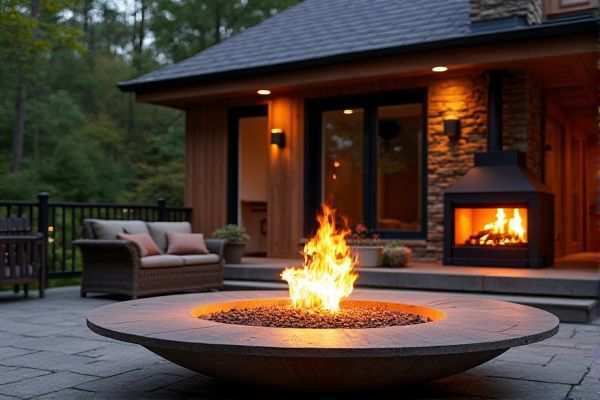
A fire pit offers an open, versatile space for warmth and social gatherings, while a chiminea provides a more contained, decorative heat source with better smoke control and safety. Discover which option best suits Your outdoor entertainment needs by reading the rest of the article.
Table of Comparison
| Feature | Fire Pit | Chiminea |
|---|---|---|
| Design | Open, bowl-shaped or ring structure | Closed, clay or metal with chimney |
| Heat Output | Radiates heat in all directions | Concentrated heat with controlled airflow |
| Smoke Control | More smoke dispersion, less control | Better smoke ventilation via chimney |
| Fuel Type | Wood, charcoal, gas | Primarily wood |
| Portability | Varies; some portable, some fixed | Usually portable and lightweight |
| Installation | Often permanent or semi-permanent | Typically no installation needed |
| Maintenance | Requires regular cleaning of ashes | Needs ash removal and occasional chimney cleaning |
| Safety | Open flames can be hazard | Enclosed fire reduces hazards |
| Cost | Generally lower initial cost | Often higher cost due to design |
| Best Use | Outdoor gatherings, cooking, ambiance | Cozy heating and decorative appeal |
Fire Pit vs Chiminea: Key Differences
Fire pits offer an open design that provides widespread heat and a social gathering space, ideal for larger outdoor areas, while chimineas feature an enclosed structure with a tall chimney to efficiently direct smoke upward, minimizing smoke exposure. Fire pits typically use wood, charcoal, or gas and allow for a more versatile experience, whereas chimineas often rely on wood and deliver focused warmth for smaller spaces. Your choice depends on the desired ambiance, heat distribution, and available outdoor space for installation.
Design and Structure Comparison
Fire pits feature an open, often circular or square design that encourages 360-degree warmth and visibility, while chimineas have a closed, bulbous body with a tall chimney that directs smoke upward and away. The structural design of fire pits allows for larger, more flexible fuel arrangements like logs or charcoal, whereas chimineas are typically optimized for burning wood with controlled airflow through their single chimney. Your choice between these depends on whether you prioritize an open, social ambiance or a self-contained, smoke-managing heat source.
Fuel Types and Efficiency
Fire pits typically use wood or charcoal, offering an authentic smoky flavor and high heat output, but they require constant attention to manage airflow and fuel consumption. Chimineas, usually made of clay or cast iron, burn wood more efficiently by concentrating heat within their enclosed design, resulting in longer burn times and less smoke. Propane or natural gas options are less common in chimineas but available for fire pits, providing cleaner combustion and easier control over fuel usage.
Heat Output and Distribution
Fire pits provide a broad heat output that radiates evenly in all directions, making them ideal for larger outdoor spaces and group gatherings. Chimineas concentrate heat in a more focused manner, directing warmth primarily to the front and immediate surrounding areas due to their enclosed design. This difference in heat distribution affects seating arrangements and comfort levels, with fire pits offering more uniform warmth and chimineas delivering intense, localized heat.
Safety Considerations
Fire pits and chimineas both require careful placement to prevent fire hazards, ideally situated on non-combustible surfaces away from structures and overhanging branches. Chiminea designs typically offer better containment of sparks and embers due to their enclosed sides, reducing the risk of accidental fires compared to open fire pits. Proper use of spark screens, regular cleaning to remove ash buildup, and adherence to local fire regulations are essential safety measures for both fire features.
Installation and Space Requirements
Fire pits generally require less installation effort and can be placed in a variety of open spaces, while chimineas often need a stable, heat-resistant surface and some clearance from walls or overhangs due to their enclosed design. Your available outdoor area determines which option fits best; fire pits suit larger, open patios, whereas chimineas work well in more compact settings with proper ventilation. Proper installation ensures safety and optimal heat distribution regardless of the choice.
Maintenance and Durability
Fire pits typically require minimal maintenance, such as regular cleaning of ashes and occasional protection from rust with covers, and are often made from durable materials like steel or cast iron, ensuring long-lasting use. Chimineas, usually constructed from clay or cast iron, demand more careful maintenance due to their susceptibility to cracking from rapid temperature changes or weather exposure, necessitating protective measures and gentle cleaning. Both structures benefit from seasonal storage and proper care to enhance their durability and performance over time.
Cost and Budget Factors
Fire pits typically offer a more budget-friendly option, with prices ranging from $100 to $1,000 depending on size and material, making them accessible for various budgets. Chimineas, often made from clay or metal, tend to be pricier, with costs between $200 and $1,200, and may require more maintenance, affecting long-term expenses. Your decision should consider both initial investment and upkeep to match your budget and outdoor heating needs.
Aesthetic Appeal and Style
Fire pits offer a modern, open-air aesthetic that complements contemporary outdoor spaces with their sleek designs and customizable shapes, providing a versatile focal point for gatherings. Chimineas, with their classic, sculptural forms often inspired by Mexican or Southwestern styles, bring a rustic charm and cozy ambiance that enhances traditional or eclectic patios. Your choice between these two will define the visual impact and atmosphere of your outdoor area, balancing functional warmth with stylistic expression.
Best Choice for Your Outdoor Space
A fire pit offers a versatile and open design ideal for larger outdoor spaces, providing warmth and ambiance with easy access for social gatherings. A chiminea features a closed, vertical structure that directs smoke upward, making it suitable for compact areas where controlled venting is essential. Your best choice depends on whether you prioritize spacious seating and open flames or a more contained, smoke-managed heating option.
 homyna.com
homyna.com